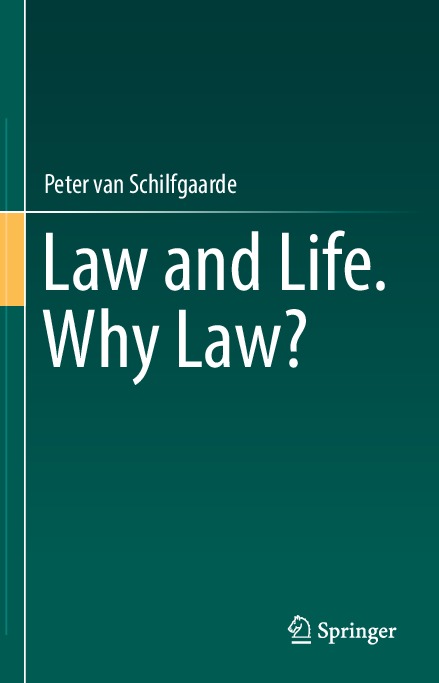File #2564: "2019_Book_LawAndLifeWhyLaw.pdf"
Testo
1|Prologue|6
1|Contents|7
1|1: Law and Life|10
2|1.1 Different Levels of Thinking|10
2|1.2 Truth, Space, and Time: Law´s Legend|12
2|1.3 The Vita Activa. Hannah Arendt|16
2|1.4 The Content of This Treatise|18
2|References|20
1|2: The Rule of Law|21
2|2.1 Why Do We Have Law? The Rule of Law|21
2|2.2 What Is Law? Law as a Human Construct|25
2|2.3 Law and Justice. Aristotle and Rawls|28
2|2.4 Law and Justice. Ricoeur and Sen|30
2|2.5 Law, Politics, and Leadership|32
2|2.6 Waldron and Rawls. Arendt on Politics. Kurt Jooss|35
2|2.7 Law and Economics|39
2|2.8 Access-Based Consumption. Sustainability|41
2|2.9 ``Bottom Up´´ Versus ``Top Down´´|45
2|2.10 Opinion, Rules, and Judgment. Reason and Reasoning|46
2|2.11 Institutional Justice and Existence-Linked Justice|50
2|References|53
1|3: Law and Society|55
2|3.1 Society and the Place Occupied by an Individual|55
2|3.2 Law and Morality|58
2|3.3 Morality in Kant´s Philosophy|61
2|3.4 Called to Freedom. Kant and Marcuse|67
2|3.5 Hegel|72
2|3.6 Connection, Cohesion, Awareness|77
2|3.7 Awareness, Common Space, and Common Time|80
2|3.8 Dignity, Respect and Responsibility. Ricoeur|83
2|3.9 Margalit and Rawls. A Sense of Justice. Ricoeur again|85
2|3.10 Taking Distance from Rawls|90
2|3.11 Trust and Confidence|92
2|3.12 Law and Rationality|93
2|3.13 Law and Equality|95
2|3.14 Law, Fundamental Rights, and Fundamental Obligations|97
2|3.15 Law and Legality|101
2|3.16 Law and War|103
2|3.17 American and English Law in History|105
2|3.18 Law and Justice in Recent English and American Literature|106
2|References|109
1|4: Homo Iuridicus Versus Homo Societatis|111
2|4.1 Professionals and Citizens. The T-Shaped Lawyer|111
2|4.2 Continuity and Change. Ownership and Transfer|114
2|4.3 Legal Rights as Challenge and Obligation|116
2|4.4 Law as Language Practice|118
2|4.5 Law as Dialogue and Discussion|120
2|4.6 Translation as Creative Mediation|123
2|4.7 External, Internal, and Substantive Translation|125
2|4.8 Misunderstanding and Misinterpretation|129
2|4.9 Knowledge in a Computerized Society. Lyotard|131
2|4.10 Practical Knowledge, Know-How, and Discourse. Lyotard revisited|134
2|4.11 Law, Objectivity, and Validity|137
2|4.12 Legal Realism|139
2|References|140
1|5: The Social Bond|142
2|5.1 Justice, Society, and the Social Bond|142
2|5.2 Law and Order|147
2|5.3 Art Versus Craft|150
2|5.4 Law, Truth, Reality, and Wisdom|152
2|5.5 Law and Wonder|154
2|5.6 Law and Life, Religion and Truth|157
2|5.7 Religion, Freedom, and Law|161
2|5.8 Law, Love, and Charisma|163
2|5.9 Law, Imagination, and Creativity|167
2|5.10 Law as Hope and Expectation|169
2|References|172
1|6: Summary and Last Remarks|174
2|6.1 Law and Life. Why Law? A Summary|174
2|6.2 Law and Life. Rhythm and Reason|177
2|Reference|178
1|Bibliography|179
1|Index|180
1|Contents|7
1|1: Law and Life|10
2|1.1 Different Levels of Thinking|10
2|1.2 Truth, Space, and Time: Law´s Legend|12
2|1.3 The Vita Activa. Hannah Arendt|16
2|1.4 The Content of This Treatise|18
2|References|20
1|2: The Rule of Law|21
2|2.1 Why Do We Have Law? The Rule of Law|21
2|2.2 What Is Law? Law as a Human Construct|25
2|2.3 Law and Justice. Aristotle and Rawls|28
2|2.4 Law and Justice. Ricoeur and Sen|30
2|2.5 Law, Politics, and Leadership|32
2|2.6 Waldron and Rawls. Arendt on Politics. Kurt Jooss|35
2|2.7 Law and Economics|39
2|2.8 Access-Based Consumption. Sustainability|41
2|2.9 ``Bottom Up´´ Versus ``Top Down´´|45
2|2.10 Opinion, Rules, and Judgment. Reason and Reasoning|46
2|2.11 Institutional Justice and Existence-Linked Justice|50
2|References|53
1|3: Law and Society|55
2|3.1 Society and the Place Occupied by an Individual|55
2|3.2 Law and Morality|58
2|3.3 Morality in Kant´s Philosophy|61
2|3.4 Called to Freedom. Kant and Marcuse|67
2|3.5 Hegel|72
2|3.6 Connection, Cohesion, Awareness|77
2|3.7 Awareness, Common Space, and Common Time|80
2|3.8 Dignity, Respect and Responsibility. Ricoeur|83
2|3.9 Margalit and Rawls. A Sense of Justice. Ricoeur again|85
2|3.10 Taking Distance from Rawls|90
2|3.11 Trust and Confidence|92
2|3.12 Law and Rationality|93
2|3.13 Law and Equality|95
2|3.14 Law, Fundamental Rights, and Fundamental Obligations|97
2|3.15 Law and Legality|101
2|3.16 Law and War|103
2|3.17 American and English Law in History|105
2|3.18 Law and Justice in Recent English and American Literature|106
2|References|109
1|4: Homo Iuridicus Versus Homo Societatis|111
2|4.1 Professionals and Citizens. The T-Shaped Lawyer|111
2|4.2 Continuity and Change. Ownership and Transfer|114
2|4.3 Legal Rights as Challenge and Obligation|116
2|4.4 Law as Language Practice|118
2|4.5 Law as Dialogue and Discussion|120
2|4.6 Translation as Creative Mediation|123
2|4.7 External, Internal, and Substantive Translation|125
2|4.8 Misunderstanding and Misinterpretation|129
2|4.9 Knowledge in a Computerized Society. Lyotard|131
2|4.10 Practical Knowledge, Know-How, and Discourse. Lyotard revisited|134
2|4.11 Law, Objectivity, and Validity|137
2|4.12 Legal Realism|139
2|References|140
1|5: The Social Bond|142
2|5.1 Justice, Society, and the Social Bond|142
2|5.2 Law and Order|147
2|5.3 Art Versus Craft|150
2|5.4 Law, Truth, Reality, and Wisdom|152
2|5.5 Law and Wonder|154
2|5.6 Law and Life, Religion and Truth|157
2|5.7 Religion, Freedom, and Law|161
2|5.8 Law, Love, and Charisma|163
2|5.9 Law, Imagination, and Creativity|167
2|5.10 Law as Hope and Expectation|169
2|References|172
1|6: Summary and Last Remarks|174
2|6.1 Law and Life. Why Law? A Summary|174
2|6.2 Law and Life. Rhythm and Reason|177
2|Reference|178
1|Bibliography|179
1|Index|180

